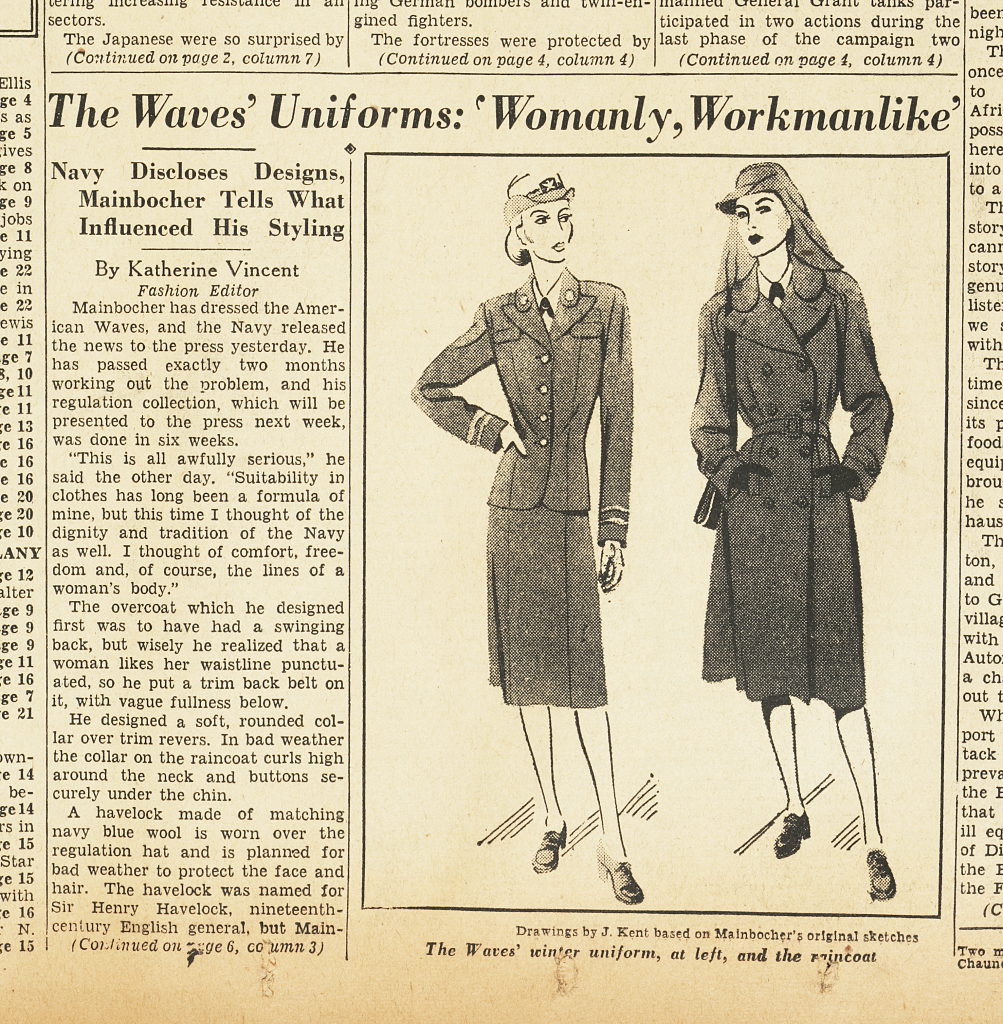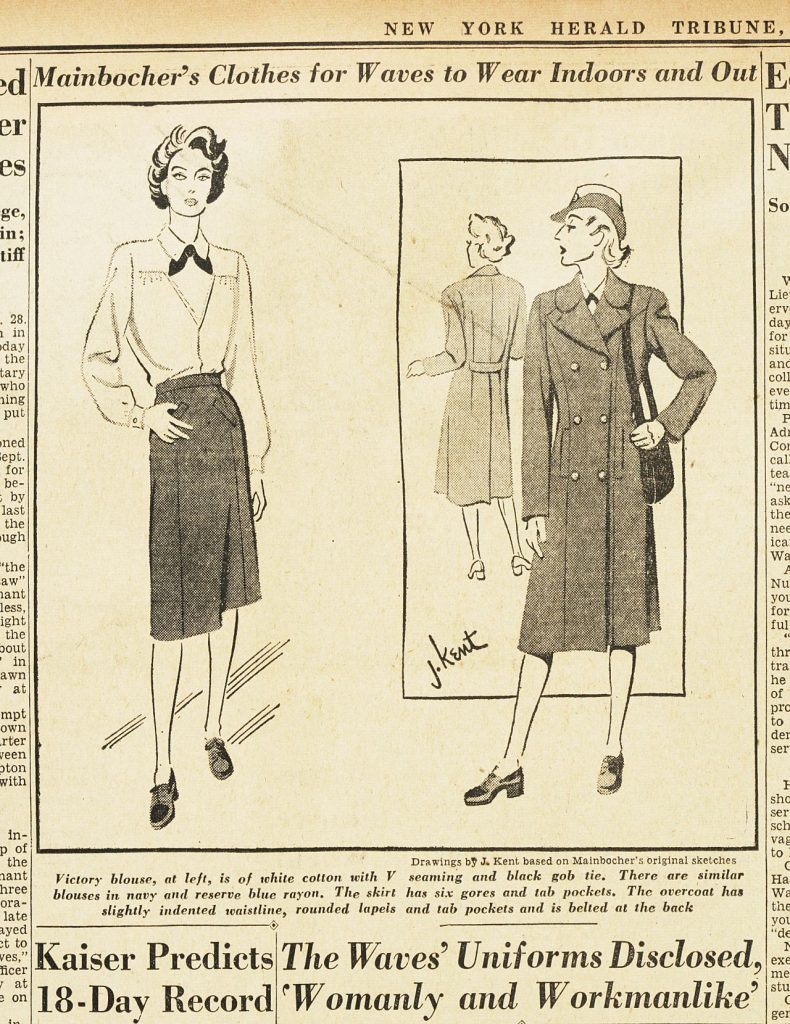Document Text |
Summary |
| The Waves’ Uniforms: ‘Womanly, Workmanlike’ Navy Discloses Designs, Mainbocher Tells What Influenced His Styling By Katherine Vincent Fashion Editor |
Fashion designer Mainbocher designed uniforms for the WAVES, the Navy’s newly formed division for women. This article was written by a fashion reporter. |
| Mainbocher has dressed the American Waves, and the Navy released the news to the press yesterday. He has passed exactly two months working out the problem, and his regulation collection, which will be presented to the press next week, was done in six weeks. | Mainbocher designed the uniforms in less than two months. The uniforms will be shown to the press in two weeks. |
| “This is all awfully serious,” he said the other day. “Suitability in clothes has long been a formula of mine, but this time I thought of the dignity and tradition of the Navy as well. I thought of comfort, freedom and, of course, the lines of a woman’s body.” | Mainbocher took the work seriously. He thought about the importance of the Navy and the work the women will do. He also wanted women to look and feel good in the uniforms. |
| The overcoat which he designed first was to have had a swinging back, but wisely he realized that a woman likes her waistline punctuated, so he put a trim back belt on it, with vague fullness below. | He revised his design of the overcoat because he wanted women to be able to accentuate their waists with a belt. |
| He designed a soft, rounded collar over trim revers. In bad weather the collar on the raincoat curls high around the neck and buttons securely under the chin. | He created a collar on the raincoat that can be pulled up high in bad weather. |
| A havelock made of matching navy blue wool is worn over the regulation hat and is planned for bad weather to protect the face and hair. The havelock was named for Sir Henry Havelock, nineteenth-century English general, but Mainbocher was inspired by the headgear of Civil war soldiers. | He included a havelock – or neck cover – that can be attached the required hat in bad weather. Civil War solider used havelocks. |
| The regulation hat is trim and free of unnecessary touches. The brim rolls up softly on both sides and ducks forward. . . | The required hat does not include unnecessary designs. It has a brim that can be rolled, depending on the occasion and the weather. |
| Further artistic juggling includes zipping out the warm lining of the raincoat. . . (There are three blouses with V for Victory in quiet seams on the front. They come in white cotton and in navy or reserve blue rayon.) | Mainbocher paid attention to details. He included a warm lining that can be removed from the raincoat. The shirt’s seams are in the shape of the letter ‘V’ for ‘Victory.’ Shirts comes in white, navy, or light blue. |
| Low-heeled shoes, shoulder-strap bags and gloves are in soft black leather and pockets on jackets and overcoats are lined in black. | The uniform also includes black shoes, bags, and gloves. |
| The regulation officers’ uniform has a semi-fitted jacket of navy blue wool, matching six-gored skirt, brass buttons and gold braid on the sleeves to denote rank. The regular enlisted women will wear the same suit but with bone buttons and no braid. The regular uniform is navy blue and the summer uniform is a duplicate in white. . . . |
There are differences between officer uniforms and non-officer uniforms. Officers wear gold buttons and a gold brain on their sleeves. Uniforms come in navy blue and summer white. |
| Mainbocher, one of the world’s greatest designers, was in the armed forces of the last world war. An American by birth, he achieved fame in Parish as an important member of the haute couture. | Mainbocher is one of the most famous designers in the world. He was in the army during World War I. |
| He told us that in the course of turning out this job for the Waves he weighed the quarter inches and the half inches. He wanted the costumes to be workmanlike, sturdy, and womanly. “These women, all American women, are going to do a fine, intelligent jobs but they do not have to look like men.” | Mainbocher told reporters that he looked at every detail during this project. He wanted the uniforms to be workmanlike and womanly. Although the women will do great work usually done by men, they deserve uniforms designed specifically for women. |
| “You can make a mistake on one dress in a collection, but think of one mistake repeated 10,000 times. That was part of my responsibility.” | Mainbocher explained that designing a uniform for thousands of women is different than making a dress that might be worn by one woman. |
| Mainbocher has volunteered his services in designing the Waves informs and the general production will be handled by several manufacturers. | Mainbocher volunteered to design the uniforms for free. Multiple factories will produce the uniforms. |
“The Waves’ Uniforms: “Womanly, Workmanlike,” The New York Herald Tribune, August 29, 1942, page 1 and 6, article and illustrations. New-York Historical Society Library.
Background
The United States Congress established the Women Accepted for Volunteer Emergency Service (WAVES) program in July 1942. The WAVES were an all-women addition the United States Navy. Like the Army’s WAACs, WAVES were trained to take on the Navy’s clerical and administrative jobs so that men could take a more active role in fighting. Over time, WAVES’ responsibilities expanded to include air traffic control, engineering, computer programming, celestial navigation, and flying airplanes.
Josephine Forrestal was the wife of the undersecretary of the Navy in 1942. Prior to marriage, she was an editor at the fashion magazine Vogue. She recommended that the Navy invite the haute couture designer Mainbocher to design WAVES uniforms. Mainbocher, who was born as Main Rousseau Bocher in Chicago in 1890, studied fashion in New York before serving in World War I. He was known for creating sleek, ladylike designs that focused on subtlety. He sold his exclusive designs from his New York City showroom. Although Mainbocher was one of the most expensive designers in the country, he charged the Navy only one dollar for his services.
The high-profile designer brought an enormous amount of attention the WAVES. The press coverage of (or reporting on) the uniforms encouraged women from across the country to enlist. It also made Mainbocher a household name. In 1948, he was invited to design uniforms for another important organization—the Girl Scouts of America.
About the Document
This article was published in the New York Herald Tribune. It was written by fashion journalist Katherine Vincent and announced Mainbocher’s designs for the WAVES. Katherine included a detailed description of the uniforms and the decisions Mainbocher made when creating them.
Vocabulary
- enlist: Join the military.
- haute couture: A French term for expensive and highly fashionable clothes created by a designer who works out of a private fashion studio or house.
- havelock: A military hat that includes fabric covering the neck to block wind, rain, and sun.
- Mainbocher: The name used by Main Rousseau Bocher, a Chicago-born fashion designer.
- overcoat: A long coat worn over other clothing.
- suitability: The quality or characteristic of being designed for a specific person or purpose.
- undersecretary: A federal government official who reports to a member of the president’s cabinet.
Discussion Questions
- Mainbocher, who designed the WAVES uniforms, described them as “womanly and workmanlike”? What does this mean and do you think he achieved his goals?
- What other questions did Mainbocher consider while designing the uniforms? What does this say about how he viewed the WAVES?
- Close to the end of the article Mainbocher explains the great responsibility he felt with this task. Why was this project important to him? How did it compare with other jobs?
- What details about the uniform does the article include? What would it have been like to wear this uniform?
- Why was it significant that the Navy hired a famous fashion designer for the uniforms?
- How do you think the public—particularly potential WAVES recruits—responded? Why?
- The idea to hire Mainbocher came from Josephine Forrestal, the wife of a Navy official and a former Vogue editor. Why do you think she made this suggestion? What does it tell you about how women were involved in the war effort?
Suggested Activities
- Learn more about the WAVES. Connect this article to the life story of Grace Hopper, as well as additional resources in the World War II & NYC curriculum guide.
- Expand your knowledge of women in the military during World War II by combining this resource with the article about the Army’s WAACs.
- Explore changes in women’s fashion from the late nineteenth century through the mid-twentieth century by analyzing these images alongside Progressive Era recreation suits and a Depression-era housedress.
- Learn more about Mainbocher and view photographs of his winter and summer WAVES designs by visiting this online exhibition. Ask students to examine the illustrations in this article and the real uniforms. How do they differ? Ask them to consider what challenges may arise in taking a fashion designer’s ideas and making it a mass-produced reality.
Themes
POWER AND POLITICS; AMERICAN CULTURE








